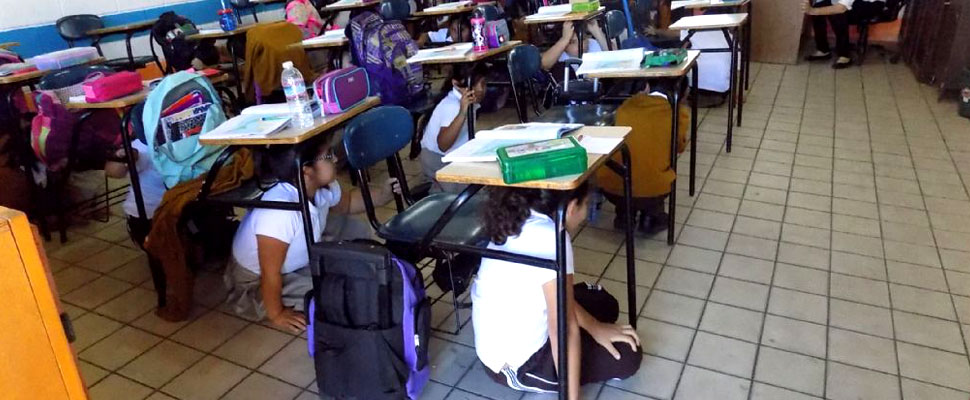What should you do in case of an earthquake?
We tell you what to keep in mind in case of a large earthquake

It has been a year since the earthquake that shook Mexico City and left 369 dead and 100 missing in different territories of the central area of the country. With a magnitude of 7.1 on the Richter scale, this tremor was one of the most devastating in recent times in the Aztec country.
Leer en español: ¿Qué debes tener en cuenta en caso de un terremoto?
Recently, on September 28, on the other side of the world, in Indonesia there was a strong earthquake accompanied by a tsunami that left devastating consequences of human losses and millionaire material damage.
Faced with such a tragedy, fear is recurrent, so being well informed is imperative to survive a large earthquake. Here are some interesting facts:
What to do in case of an earthquake?
The National Unit for Disaster Risk Management of Colombia prepared a detailed manual describing what should be done before, during, and after a quake. We tell you some recommendations:
- If you are in an earthquake-resistant building, locate yourself near columns, under desks or in demarcated areas as safe, away from windows or glassware and places where there is a risk of falling objects.
- If you are in an informal building, leave it immediately and check around to identify risks and avoid them.
- Never use elevators to evacuate.
- Do not locate yourself under the doorframes.
- If you are in a wheelchair, go to a column or safe place. Protect your head with your arms and make sure that the place where you spend most time has the necessary measures for evacuation.
- If you are at home, open the main doors and the rooms, this in order to avoid situations of confinement.
- If you are lying down and cannot move, cover your head with your arms or a pillow.
After the earthquake
- Verify that you are well, as well as your family and friends.
- If you are at home and the earthquake was very strong, cut off gas, water, and electricity supplies. Give notice to firefighters in case of smelling gas.
- Check the structure of your house to discard or confirm cracks, inclined structures with risk of collapse.
- Apply first aid if you know how to do it, otherwise, expect specialized care to get to where you are
- Stay informed through the radio and media about what you can do.
What is the risk?
Latin America has the risk of suffering earthquakes of different magnitudes since its geographical location is over the so-called Pacific Ring of Fire, an area in which great seismic and volcanic activity occurs.
The Latin American countries marked by the belt are Chile, Argentina, Bolivia, Peru, Ecuador, Colombia, Panama, Costa Rica, Nicaragua, El Salvador, Honduras, Guatemala, and Mexico. This is determined by the researcher Hernando Tavera, director of the Geophysical Institute of Peru.
For cities, it could be thought that Santiago de Chile or Mexico City would be more prone to suffer some earthquake movement of great intensity. However, according to Tavera, the capital of Peru has major risk of suffering a catastrophe.
You may also be interested: When we make the earth tremble
"Science cannot predict the earthquake but it has been possible to forecast the occurrence, it can be seen in what area there is a large accumulation of energy and that has shown us that there is a large area facing the department of Lima that does not release energy from the year 1746, and that would give rise to an earthquake of rather large magnitude", he told América Noticias.
How vulnerable is Latin America?
"Earthquakes are unpredictable, but they can be prevented," says geologist Patricio Valderrama for AFP. "The earthquake does not kill, people lose their lives because structures collapse, because they have been poorly built or built on soils that are not adequate", he adds.
The Inter-American Development Bank says that about 60 million people in Latin America live in homes that are not suitable to withstand a major earthquake, mainly because they are informal buildings that do not fit the basic needs of families.
Adding to this difficulty, there is the lack of prevention, Valderrama declares. Many cities and governments do not have enough resources to, at least, activate information campaigns and simulations that allow citizens to know what to do in case of an earthquake. However, the great concern is the economic deficit of governments facing the phenomenon of informality in the construction of low-income housing, which is why developing countries are the most vulnerable in the face of seismic catastrophes.
LatinAmerican Post | Jorge Becerra
Translated from “¡Terremoto! ¿Qué debes tener en cuenta en caso de sismo?”
Listen this article





